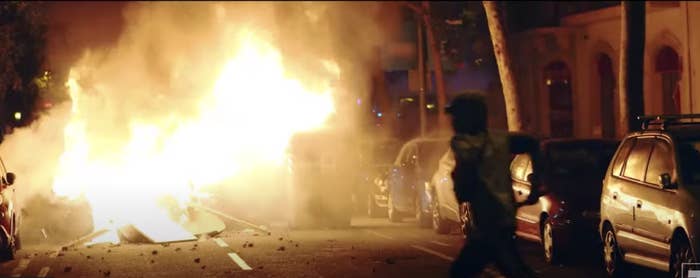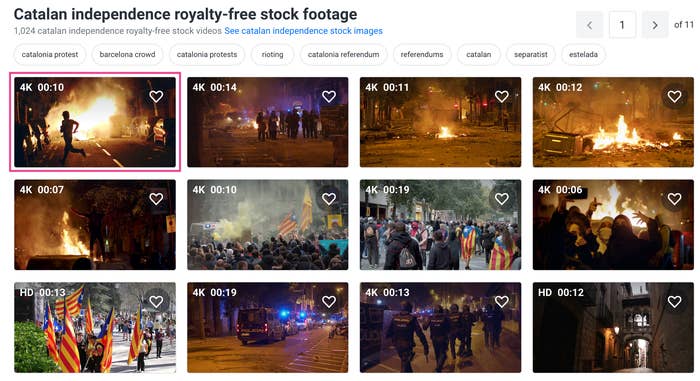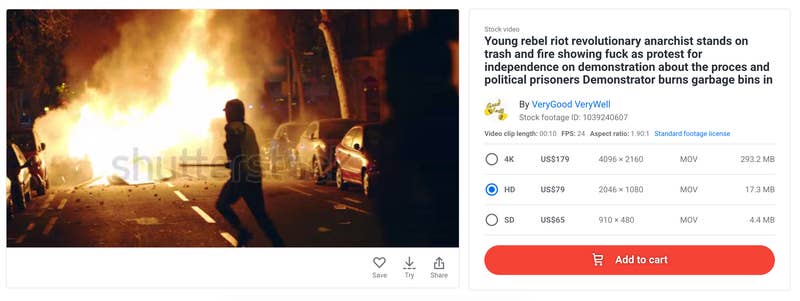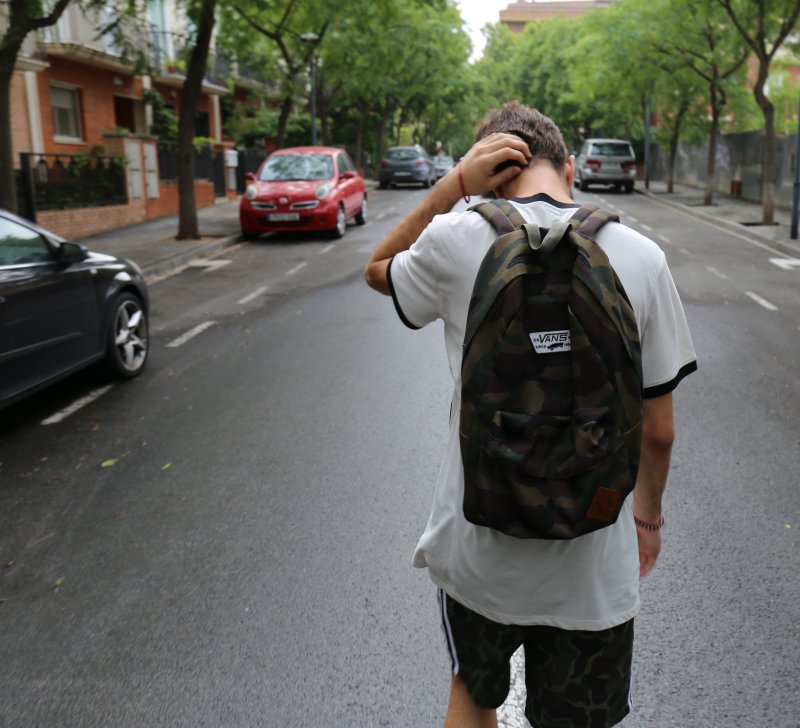Issued on: 28/08/2020

An ICU team at work in a Wuhan hospital in Ai Weiwei's documentary, 'Coronation'. © Ai Weiwei Films
Text by:Leela JACINTO
"Coronation", Chinese artist and activist Ai Weiwei’s latest documentary directed remotely from Europe, probes how ordinary citizens in Wuhan coped during the height of the coronavirus pandemic under the gaze of the all-monitoring state determined to relay a narrative of efficiency, not human loss or sorrow.
An elderly Chinese mother and her adult son under lockdown in her apartment are going through the awards the retired woman won during her loyal service to the Communist Party in the ranks of “ordinary cadres” as she describes it.
Merit plaques, in ceremonial red and gold wrapping, are being plunked, one after the other, on the table. “Look! Look! Look!” she mutters with every thump as her son – clearly not a Party believer, but still indulging his mother – chuckles.

Li Wen, an artist, and his mother during the Wuhan lockdown © Ai Weiwei Films
Next, a roll of old certificates is flattened on the table. “You kept all of them,” says the son as he rattles out the certification years. “This one’s torn,” he suddenly exclaims. “This was written by Lin Biao in 1970. Making Revolution. Mao Zedong Thought,” he reads from the ripped paper. “Lin Biao wrote it. No wonder you tore it,” he chortles.
“I didn’t. I didn’t,” replies the old woman unsmiling as her son, an artist, giggles.
“Then who tore it?” teases her son.
The old woman though is not amused. “No idea,” she sternly replies. And with that, the matter is closed.
Lin Biao was at the peak of his career as First Vice Chairman of the Communist Party of China (CPC) when he signed the elderly mother’s 1970 certificate. He was CPC founder Mao Zedong’s right-hand man during the excesses of the Cultural Revolution, which decimated the Chinese economy, cultural tradition and killed millions, according to historians still debating death tolls.
When the Cultural Revolution, which was launched by Mao, ended in 1976, Lin was officially designated a “traitor”. A once loyal party servant was made the fall guy and the chapter was declared closed, eliciting tight “No idea” dismissals from “ordinary party cadres” four decades later.
The mother-son conversation occurred in an apartment in the central Chinese province of Hubei earlier this year under a lockdown, better known as the “Wuhan lockdown” after the provincial capital and epicentre of the coronavirus pandemic.
It’s one of many revealing scenes in Coronation, a nearly two-hour documentary by leading Chinese artist and activist Ai Weiwei, released this week.
As China experiences yet another turmoil in its long history, the contest for the narrative of the coronavirus chapter is up for grabs. With Beijing seeking superpower status, the winning interpretation could have national and global implications.
Coronation provides both, the official narrative touted by Chinese authorities, as well as the counter-narrative that Beijing is at pains to conceal. The historical verdict is likely to focus on Hubei during the December 2019 to January 2020 period, when the first cases of a pneumonia-like infection were detected in Wuhan before the infection tore through the world, killing more than 800,000 people so far and wreaking havoc on the global economy.
‘Everything started 17 years ago’
The documentary begins on January 23, the day Wuhan went into a lockdown, and ends on April 8, when the restrictions were finally lifted, following five main characters as they navigate the tight constraints.
Ai, who has been living in exile in Europe since 2015, made Coronation remotely and in secret, providing directions to amateur cinematographers filming in the epicentre as well as securing already filmed material.
The 63-year-old contemporary artist declined to disclose details of the filming or how he accessed footage to protect the people in China who worked on the project. But Ai has past experience in video art projects: his prodigious multimedia oeuvre includes guerrilla-style documentaries and short clips that cast a raw lens on social issues.
Back in 2003, while he was still in China, Ai produced a 26-minute short, Eat, Drink and Be Merry, during the SARS outbreak, which is believed to have originated in the southern Chinese city of Guangdong. Beijing’s handling of the SARS outbreak, including discouraging press coverage and delayed reporting to the World Health Organization (WHO), drew international criticism.
So, when the news of the latest outbreak in Wuhan started to emerge, Ai immediately plugged into the situation with a clear idea of the medium he would employ for his next project.
“From the very beginning I was thinking of how to structure a film without being in that city,” said Ai in an emailed response to FRANCE 24. “Two conditions made it impossible: First, I was forced out from China since 2015, living almost like a political refugee. Second, on January 23, Wuhan was shut down. No one was allowed in or out. Before that, we already began to think of how to achieve a documentary.”
The 2003 experience proved critical, said Ai. “Eat, Drink and Be Merry is probably the only independent documentary made about SARS, about Beijing and how the government covered up information which caused a public panic. So, everything started 17 years ago,” he noted.
The efficient, all-watching state
Coronation though is very different from the wry, exuberantly defiant Eat, Drink and Be Merry.
But then China in 2020 is not quite like the China of 2003.
Beijing’s global ambitions, regional expansionism, crackdowns against minorities and clampdowns in autonomous zones have increased under President Xi Jinping. The mounting human rights violations have also sparked a heightened official defensiveness, marked by China’s aggressive “wolf warrior” diplomacy on the international stage and increased surveillance inside the country.
Technology has also aided the state’s scrutiny of its citizens and the pandemic has provided the perfect justification to monitor every move they make.
Coronation begins with a couple returning from a Chinese New Year break in their ancestral province to Wuhan, where they work, on the night of January 23.
Driving through desolate, snowy streets, they stop at a petrol station, where a shivering attendant tries but fails to take their temperatures. Within minutes, a police car pulls up. The couple’s self-isolation papers and IDs are checked and, a few questions later, they are allowed to carry on, a procedure accomplished with utmost calm and efficiency.
Beijing has been keen to highlight its efficient handling of the crisis and Coronation shows that the single-party state did indeed put up a public health feat by the end of January.
Medical teams arrive from across China to Wuhan, cheered by synchronised “Go Wuhan!” chants from masked reception teams at the airport. Robots disinfect public areas. Inside hospitals, audio tracks of beeps from medical equipment accompany nursing teams in protective gear as they treat patients in a bleak, dystopian universe.

Next, a roll of old certificates is flattened on the table. “You kept all of them,” says the son as he rattles out the certification years. “This one’s torn,” he suddenly exclaims. “This was written by Lin Biao in 1970. Making Revolution. Mao Zedong Thought,” he reads from the ripped paper. “Lin Biao wrote it. No wonder you tore it,” he chortles.
“I didn’t. I didn’t,” replies the old woman unsmiling as her son, an artist, giggles.
“Then who tore it?” teases her son.
The old woman though is not amused. “No idea,” she sternly replies. And with that, the matter is closed.
Lin Biao was at the peak of his career as First Vice Chairman of the Communist Party of China (CPC) when he signed the elderly mother’s 1970 certificate. He was CPC founder Mao Zedong’s right-hand man during the excesses of the Cultural Revolution, which decimated the Chinese economy, cultural tradition and killed millions, according to historians still debating death tolls.
When the Cultural Revolution, which was launched by Mao, ended in 1976, Lin was officially designated a “traitor”. A once loyal party servant was made the fall guy and the chapter was declared closed, eliciting tight “No idea” dismissals from “ordinary party cadres” four decades later.
The mother-son conversation occurred in an apartment in the central Chinese province of Hubei earlier this year under a lockdown, better known as the “Wuhan lockdown” after the provincial capital and epicentre of the coronavirus pandemic.
It’s one of many revealing scenes in Coronation, a nearly two-hour documentary by leading Chinese artist and activist Ai Weiwei, released this week.
As China experiences yet another turmoil in its long history, the contest for the narrative of the coronavirus chapter is up for grabs. With Beijing seeking superpower status, the winning interpretation could have national and global implications.
Coronation provides both, the official narrative touted by Chinese authorities, as well as the counter-narrative that Beijing is at pains to conceal. The historical verdict is likely to focus on Hubei during the December 2019 to January 2020 period, when the first cases of a pneumonia-like infection were detected in Wuhan before the infection tore through the world, killing more than 800,000 people so far and wreaking havoc on the global economy.
‘Everything started 17 years ago’
The documentary begins on January 23, the day Wuhan went into a lockdown, and ends on April 8, when the restrictions were finally lifted, following five main characters as they navigate the tight constraints.
Ai, who has been living in exile in Europe since 2015, made Coronation remotely and in secret, providing directions to amateur cinematographers filming in the epicentre as well as securing already filmed material.
The 63-year-old contemporary artist declined to disclose details of the filming or how he accessed footage to protect the people in China who worked on the project. But Ai has past experience in video art projects: his prodigious multimedia oeuvre includes guerrilla-style documentaries and short clips that cast a raw lens on social issues.
Back in 2003, while he was still in China, Ai produced a 26-minute short, Eat, Drink and Be Merry, during the SARS outbreak, which is believed to have originated in the southern Chinese city of Guangdong. Beijing’s handling of the SARS outbreak, including discouraging press coverage and delayed reporting to the World Health Organization (WHO), drew international criticism.
So, when the news of the latest outbreak in Wuhan started to emerge, Ai immediately plugged into the situation with a clear idea of the medium he would employ for his next project.
“From the very beginning I was thinking of how to structure a film without being in that city,” said Ai in an emailed response to FRANCE 24. “Two conditions made it impossible: First, I was forced out from China since 2015, living almost like a political refugee. Second, on January 23, Wuhan was shut down. No one was allowed in or out. Before that, we already began to think of how to achieve a documentary.”
The 2003 experience proved critical, said Ai. “Eat, Drink and Be Merry is probably the only independent documentary made about SARS, about Beijing and how the government covered up information which caused a public panic. So, everything started 17 years ago,” he noted.
The efficient, all-watching state
Coronation though is very different from the wry, exuberantly defiant Eat, Drink and Be Merry.
But then China in 2020 is not quite like the China of 2003.
Beijing’s global ambitions, regional expansionism, crackdowns against minorities and clampdowns in autonomous zones have increased under President Xi Jinping. The mounting human rights violations have also sparked a heightened official defensiveness, marked by China’s aggressive “wolf warrior” diplomacy on the international stage and increased surveillance inside the country.
Technology has also aided the state’s scrutiny of its citizens and the pandemic has provided the perfect justification to monitor every move they make.
Coronation begins with a couple returning from a Chinese New Year break in their ancestral province to Wuhan, where they work, on the night of January 23.
Driving through desolate, snowy streets, they stop at a petrol station, where a shivering attendant tries but fails to take their temperatures. Within minutes, a police car pulls up. The couple’s self-isolation papers and IDs are checked and, a few questions later, they are allowed to carry on, a procedure accomplished with utmost calm and efficiency.
Beijing has been keen to highlight its efficient handling of the crisis and Coronation shows that the single-party state did indeed put up a public health feat by the end of January.
Medical teams arrive from across China to Wuhan, cheered by synchronised “Go Wuhan!” chants from masked reception teams at the airport. Robots disinfect public areas. Inside hospitals, audio tracks of beeps from medical equipment accompany nursing teams in protective gear as they treat patients in a bleak, dystopian universe.

Medical teams in Wuhan, China, get disinfected in a still from Ai Weiwei's "Coronation". © Ai Weiwei Films
Wuhan’s much touted emergency field hospitals, constructed within two weeks, are also on display in the film. In one characteristically Ai Weiwei sequence, a doctor enters through the front door of a just-built field hospital and walks for nearly four minutes, the camera following him in a single shot, as he makes his way through labyrinthine corridors, with signs scrawled on the new walls with markers, until he finally reaches his examination door.
Trying to grieve without apparatchiks
The state response grows more sinister in the second half of the documentary as a son tries to collect the ashes of his father, a Covid-19 victim, alone, without the deceased’s work unit members accompanying the grieving son.
There is no place for grief or a processing of sorrow in the People’s Republic of China. Nothing that can contradict the state narrative of cheery, “win-win” efficiency is allowed. Functionaries, party members, work unit colleagues and sundry officials hustle relatives through a mind-numbing bureaucracy of death, hovering over rushed burials, hurrying loved ones, numbed with grief, along.
Since the filming of the documentary, one of the five main characters – a construction worker brought into Wuhan to build hospitals but then barred from returning to his home province – has committed suicide.

Wuhan’s much touted emergency field hospitals, constructed within two weeks, are also on display in the film. In one characteristically Ai Weiwei sequence, a doctor enters through the front door of a just-built field hospital and walks for nearly four minutes, the camera following him in a single shot, as he makes his way through labyrinthine corridors, with signs scrawled on the new walls with markers, until he finally reaches his examination door.
Trying to grieve without apparatchiks
The state response grows more sinister in the second half of the documentary as a son tries to collect the ashes of his father, a Covid-19 victim, alone, without the deceased’s work unit members accompanying the grieving son.
There is no place for grief or a processing of sorrow in the People’s Republic of China. Nothing that can contradict the state narrative of cheery, “win-win” efficiency is allowed. Functionaries, party members, work unit colleagues and sundry officials hustle relatives through a mind-numbing bureaucracy of death, hovering over rushed burials, hurrying loved ones, numbed with grief, along.
Since the filming of the documentary, one of the five main characters – a construction worker brought into Wuhan to build hospitals but then barred from returning to his home province – has committed suicide.

Meng Liang, a construction worker, works his phone trying to get home from Wuhan in a still from Ai Weiwei's "Coronation". © Ai Weiwei Films
Another, a son determined to grieve for his father without hovering, monitoring apparatchiks, is right now “under heavy surveillance by the public security”, according to Ai.
The artist in exile has also faced pressure from Chinese authorities due to Coronation. “Since the film came out, the public security has contacted my mum, trying to convey the kind of trouble this film has made for China. I suggested that they watch the film, inviting them to have a discussion with me on whatever point they disagreed with and why they think a film with such an objective point of view could cause a tremendous crisis in terms of ideological discussion,” revealed Ai.
Censorship, self-censorship inside and outside China
Since he rose to national and international prominence in the late 1990s. Ai has critiqued and provoked the Chinese political establishment with his daring multimedia works, tackling themes such as corruption and the state’s assault on personal liberties. The Communist Party’s gigantic structure, employed in the pursuit of stability, a Chinese obsession, has many adherents in the country.
Ai puts it down to state thought-control. Discussing the generational divide between the elderly, party award-winning mother and her artist son, he noted that, “It is clear that the elderly generation are in stronger support of the system. But the younger generation are not much different from the older generation. You can see how successful the authoritarian regime has been in controlling information and in brainwashing over the past 70 years. There is no foundation for questioning or criticism of any sort.”
But if there’s censorship inside the country, there’s also a form of market-driven self-censorship outside China, Ai believes. The legendary contemporary artist said he initially wanted to showcase Coronation at film festivals. But so far, there have been no takers.
“They are heavily dependent on the sales market and China provides the biggest market,” he noted. “None of them can avoid not to bow their heads toward this attractive market. All filmmakers, including the festivals which host their films, desire to have their films presented in China. That clearly illustrates why all those festivals and production companies self-censor.”
"Coronation" can be viewed on Vimeo on Demand (globally, except the US) and on Alamo on Demand in the US.
Another, a son determined to grieve for his father without hovering, monitoring apparatchiks, is right now “under heavy surveillance by the public security”, according to Ai.
The artist in exile has also faced pressure from Chinese authorities due to Coronation. “Since the film came out, the public security has contacted my mum, trying to convey the kind of trouble this film has made for China. I suggested that they watch the film, inviting them to have a discussion with me on whatever point they disagreed with and why they think a film with such an objective point of view could cause a tremendous crisis in terms of ideological discussion,” revealed Ai.
Censorship, self-censorship inside and outside China
Since he rose to national and international prominence in the late 1990s. Ai has critiqued and provoked the Chinese political establishment with his daring multimedia works, tackling themes such as corruption and the state’s assault on personal liberties. The Communist Party’s gigantic structure, employed in the pursuit of stability, a Chinese obsession, has many adherents in the country.
Ai puts it down to state thought-control. Discussing the generational divide between the elderly, party award-winning mother and her artist son, he noted that, “It is clear that the elderly generation are in stronger support of the system. But the younger generation are not much different from the older generation. You can see how successful the authoritarian regime has been in controlling information and in brainwashing over the past 70 years. There is no foundation for questioning or criticism of any sort.”
But if there’s censorship inside the country, there’s also a form of market-driven self-censorship outside China, Ai believes. The legendary contemporary artist said he initially wanted to showcase Coronation at film festivals. But so far, there have been no takers.
“They are heavily dependent on the sales market and China provides the biggest market,” he noted. “None of them can avoid not to bow their heads toward this attractive market. All filmmakers, including the festivals which host their films, desire to have their films presented in China. That clearly illustrates why all those festivals and production companies self-censor.”
"Coronation" can be viewed on Vimeo on Demand (globally, except the US) and on Alamo on Demand in the US.









